Disclosure: this post contains affiliate links: I will earn a small commission, if you make a purchase through these links, without any additional cost to you.
Washington DC: capital of the United States, symbol of power, burocracy and democracy; center of political controversies, scandals and backstabbings. This sums up what Washington DC is in popular imagination.
Washington DC is not a very large city, compared to other American metropoles: its population was about 705,000 people in 2019. Washington DC is not actually part of any US state, as it is part of the District of Columbia (that’s what DC stands for). It is located on the Potomac River on the East Coast of the United States and it borders Maryland and Virginia. The city is named after the first United States President, George Washington, while the district’s name remembers Cristoforo Colombo.
Walking along the streets of Washington DC, you will be amazed by its neoclassical architecture: majestic white marble buildings and monuments characterize the city, giving it a sense of austerity, power and heritage at the same time. Most of them are famous all over the world: the White House, the Capitol, the Washington Monument and the Lincoln Memorial just to name a few. They will definitely remind you of famous landmarks from ancient Greece and the Roman Empire. A walk through Washington DC is a journey through the history of the United States, from their indipendence back in 1776, and then through the Civil War, the two World Wars, the Korean War and the Vietnam War. It is a very emotional path without doubt.
In this post I am going to show you how to check all the historic landmarks of Washington DC in a one-day walking tour, with a short detour in Virginia too! I know: it’s quite packed! In my case, I arrived in Washington DC the day before, so I could start visiting the city early in the morning after a good sleep. I suggest you do the same, otherwise it would be too rush.
How to get to Washington DC
Washington DC has an international airport, named Dulles International Airport (IATA: IAD), with connections to all major cities in Europe. There are other two airports in Washington DC metropolitan area, the Ronald Reagan Washington National Airport (IATA: DCA) and the Baltimore/Washington International Thurgood Marshall Airport (IATA: BWI), with domestic flights to other US cities.
Otherwise, you can get to Washington DC by train or bus if you depart from other cities on the East Coast. Check out Amtrak website for train routes. For instance, I travelled from Boston to Washington DC by train: it took about eight hours and it was a very relaxing journey. Trains depart from the Union Station in Downtown Washington DC.
Finally, you can also check out bus companies like Greyhound or Megabus: tickets are really cheap if you book early. After visiting the city, I took a trip from Washington DC to New York City by bus and it took about four hours and a half.
How to get around Washington DC
The Metrorail system (simply called Metro) is the best way to get around Washington DC. Metro is made of six different lines, identified with six different colours. You will need a smart card to access it. Check out Washington Metropolitan Area Transit Authority website for further information about getting around Washington DC.
When to visit Washington DC
I went on this trip in July 2011 and I remember it was a very hot day with a lot of humidity. So, I suppose that it would be much more enjoyable to visit Washington DC either in spring or in autumn, when temperatures are lower.
One-day walking tour itinerary in Washington DC
So, let’s see how to check out Washington DC’s main historic monuments, buildings and memorials in a one-day walking tour. I haven’t considered museums (the Smithsonian above all), as it would require more days. I have set the Union Station as a convenient starting point of this walk: of course, you can start it from your accomodation in Washington DC. For instance, I stayed at the marvellous Renaissance Washington DC Downtown Hotel.
As usually, I marked only the main landmarks of the itinerary on the map. Moreover, at the bottom left corner of the map you can see the Arlington National Cemetery: to get there you will need to take the Metro. These are the landmarks of Washington DC marked on the map in a possible order for visiting them in a one-day itinerary. Most of them are located along the National Mall, the large park that stretches from Capitol Hill on the east end to the Lincoln Memorial on the west end.
- A: Washington Union Station
- B: United States Capitol
- Arlington National Cemetery (via Metro)
- C: Washington Monument
- D: White House
- E: Vietnam Women’s Memorial
- F: Lincoln Memorial
- G: Korean War Memorial
- H: Franklin Delano Roosevelt Memorial
- I: Thomas Jefferson Memorial
- J: Washington Union Station
As you can see, after checking out the United States Capitol, you can take the Metro and get to Arlington National Cemetery; after your visit, you can get back to the National Mall by Metro again. If you don’t have enough time, you can just skip Arlington National Cemetery and continue your walk through the National Mall. However, I do recommend you don’t miss Arlington National Cemetery, as it is a really emotional experience.
Not including a visit to Arlington National Cemetery, this loop trail is about 8.3 miles (13.4 km) long in total.
So, let’s start this walk (or perhaps should I say hike?)!
Washington Union Station
If you get to Washington DC by train, you will get your first impression of what this city looks like at Union Station, opened in 1907. You will be amazed by its majestic marble vaults and floors, that reflect the elegant neoclassical style so spread throughout Washington DC.

In front of Union Station, you will find the Freedom Bell, a replica of the Liberty Bell located in Philadelphia, a symbol of American independence.
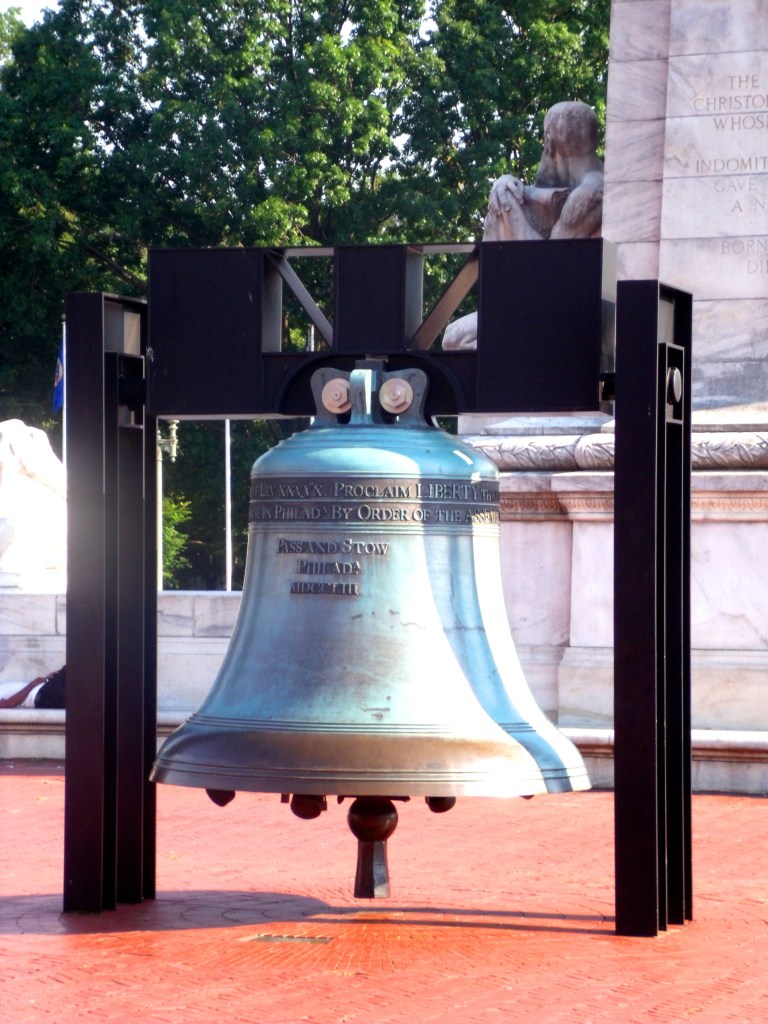
United States Capitol
Walking south, you get to the United States Capitol, the building where Congress gathers. It is located on Capitol Hill on the east end of the National Mall. You will definitely recognize it, as you have seen it on TV so many times. Built in 1800, the Capitol is a beautiful example of neoclassical architecture, featuring a magnificent dome on top of it. You can visit the U.S. Capitol for free: keep in mind that booking in advance is recommended (visitors must access from the East Front).

From the West Front of the Capitol you can have a great view of the entire National Mall. Just in front of it, you will find the Ulysses S. Grant Memorial, remembering the general of the Civil War.

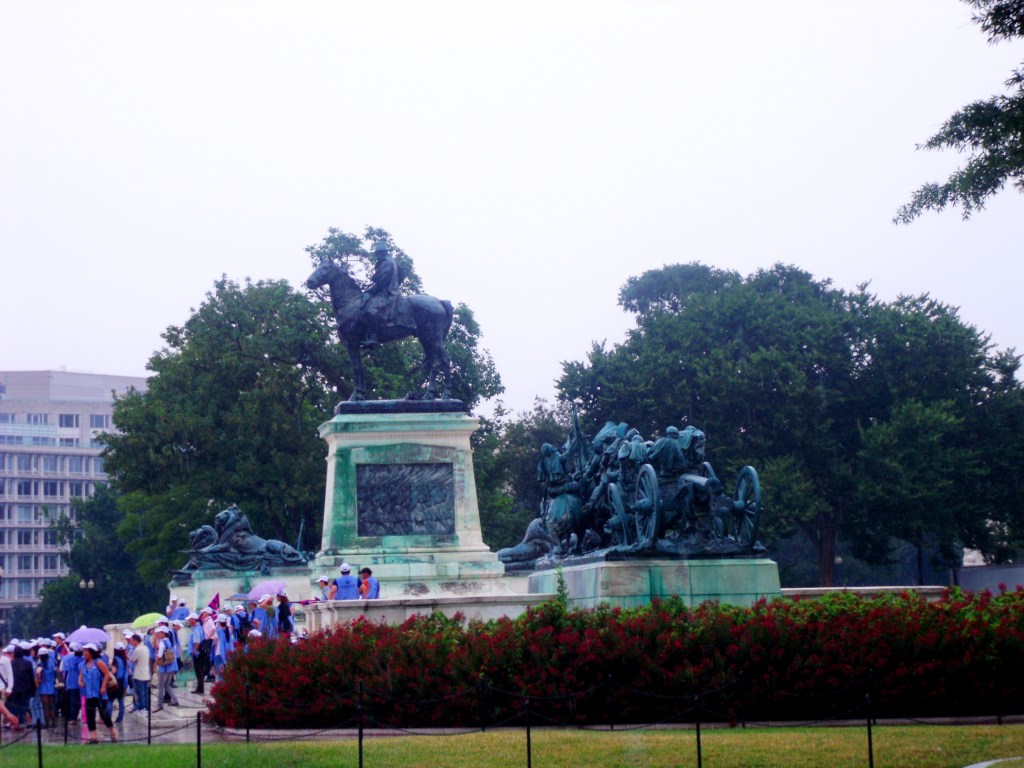
Supreme Court of the United States
Located just one block east of the Capitol, the United States Supreme Court building is another piece of neoclassical architecture and resembles an ancient Greece temple. It definitely inspires authority, justice and dignity. The Supreme Court building is open to visitors for free too.
On the architrave of the west entrance of this majestic building the following motto is incised:
“Equal Justice Under Law”

Arlington National Cemetery
If you wish to visit Arlington National Cemetery (which I highly recommend), now you can walk south along First Street SE for a couple of blocks and take the Metro at Capitol South Station: take the blue line to Franconia-Springfield and get off at the Arlington Cemetery Station.
Arlington National Cemetery is considered the United States most hallowed ground: its gardens cover a huge area of 639 acres on a hill, where over 14,000 American soldiers and airmen rest in peace. Visiting Arlington National Cemetery is definitely an emotional experience: remember to keep a respectful behaviour when you visit this place.
At the north end of the cemetery, you will find the US Marine Corps War Memorial, that remembers the wars fought by US Marines over the years.

Then, you can walk along the paths on the hillside, through the thousands of white stone graves that dot the landscape. It is impressive how many they are.

Walking uphill, you will find the President John F. Kennedy Gravesite, where the members of the Kennedy family are buried and an eternal flame burns.
Finally, at the top of the hill, you will find the Memorial Amphitheater: this majestic neoclassical monument hosts several official memorial services throughout the year. Moreover, the President usually holds a speech at Memorial Amphitheater on Memorial Day.
Next to the Memorial Amphitheater, you will find The Tomb of the Unknown Soldier, definitely the most iconic and famous monument in Arlington National Cemetery. The Tomb of the Unknown Soldier remembers those deceased soldiers who have not been identified after their deaths in war. This white marble tomb is the resting place of an unknown soldier from World War I. Today the tomb is guarded 24/7 and the changing of the guard is one of the most emotional ceremony I ever attended to, being highly symbolic. During the guard change the public is required to be silent, which makes this elaborate ceremony even more memorable. On one side of the Tomb of the Unknown Soldier the following sentence is written:
“Here rests in honored glory an American soldier known but to God”
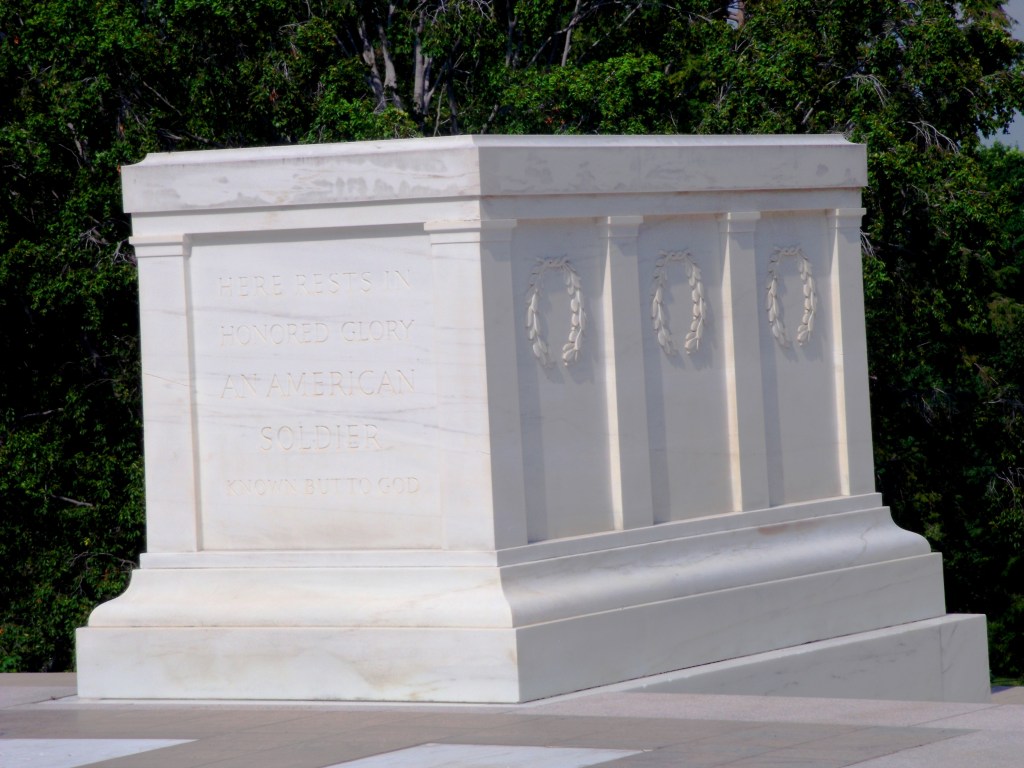
Washington Monument
After your visit to Arlington National Cemetery you can get back to the National Mall by Metro: just take the blue line again, this time to Largo Town Center and get off at the L’Enfant Plaza Station. From here, just walk north for a couple of blocks and you will be back at the National Mall. Walking west you will find the Washington Monument, another iconic landmark of the city, standing about 555 feet (169 m) tall. This huge marble obelisk was completed in 1888 to honor George Washington. You can get to the top of the Washington Monument by the elevator inside: remember to buy your ticket online the day before your visit.
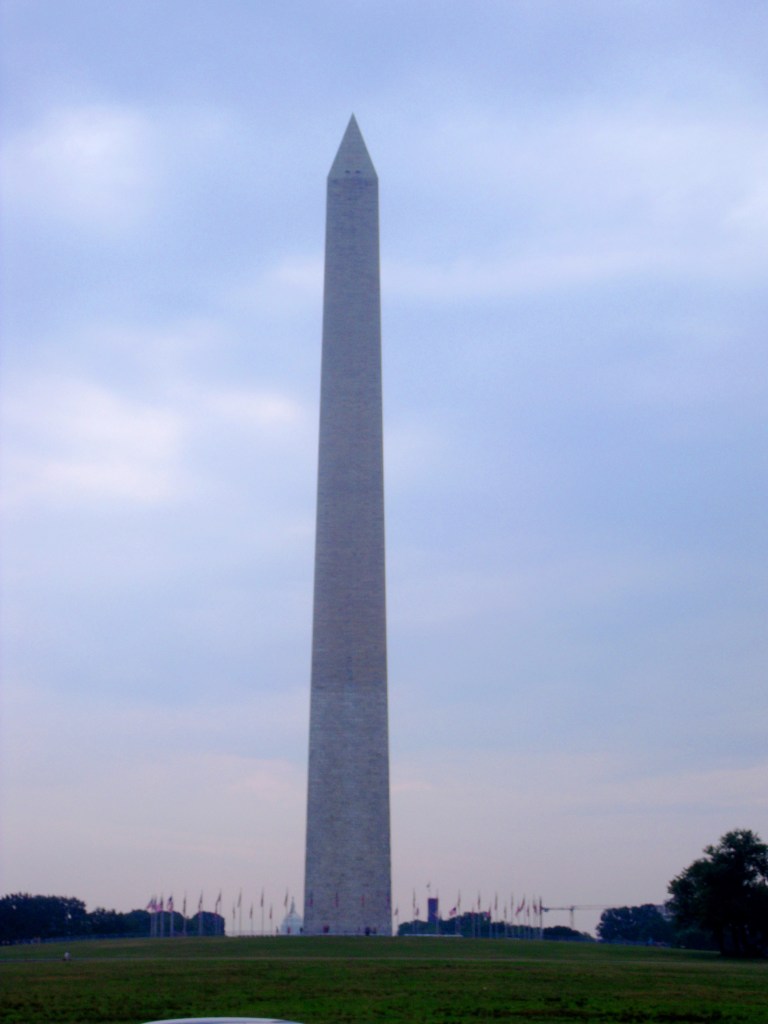
The White House
From the Washington Monument, now you can walk north along 15th street NW, until you get to Pennsylvania Avenue. Turn left onto this pedestrian street closed to traffic. After a few steps on your left, at 1600 Pennsylvania Avenue NW, you will find one of the most iconic and famous buildings in the world, the White House, the residence of the President of the United States. Completed in 1800, the White House is another example of neoclassical architecture. Unlike other buildings in Washington DC, a visit to the White House must be planned in advance: American visitors are supposed to contact their member of Congress, while international visitors must contact their embassy in Washington DC.

World War II Memorial
After taking some pictures of the White House, you can keep walking along Pennsylvania Avenue and then turn left onto 17th Street NW: after a few blocks you will be back at the National Mall and, on your right, you will find the World War II Memorial.
The World War II Memorial, completed in 2004, honors the Americans who served in the US army and died during World War II. This majestic circular monument is made of 56 granite pillars, representing US states and territories, two arches at the north and south sides and a fountain in the middle.

Vietnam Veterans Memorial and Vietnam Women’s Memorial
Walking west through the World War II Memorial, you will find the Lincoln Memorial Reflecting Pool. At the end of it, on your right, you will find first the Vietnam Women’s Memorial and then the Vietnam Veterans Memorial, a huge black granite wall where the names of the American soldiers fallen during the Vietnam War are engraved. Like Arlington National Cemetery, these memorials will trigger some emotional reactions too.
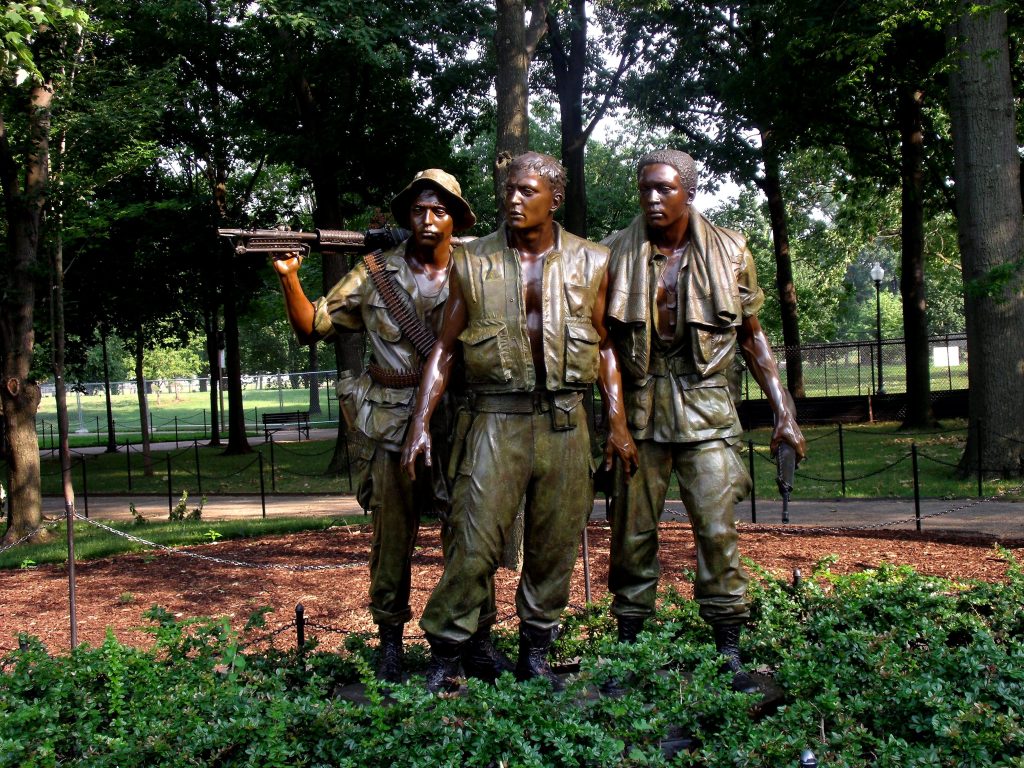
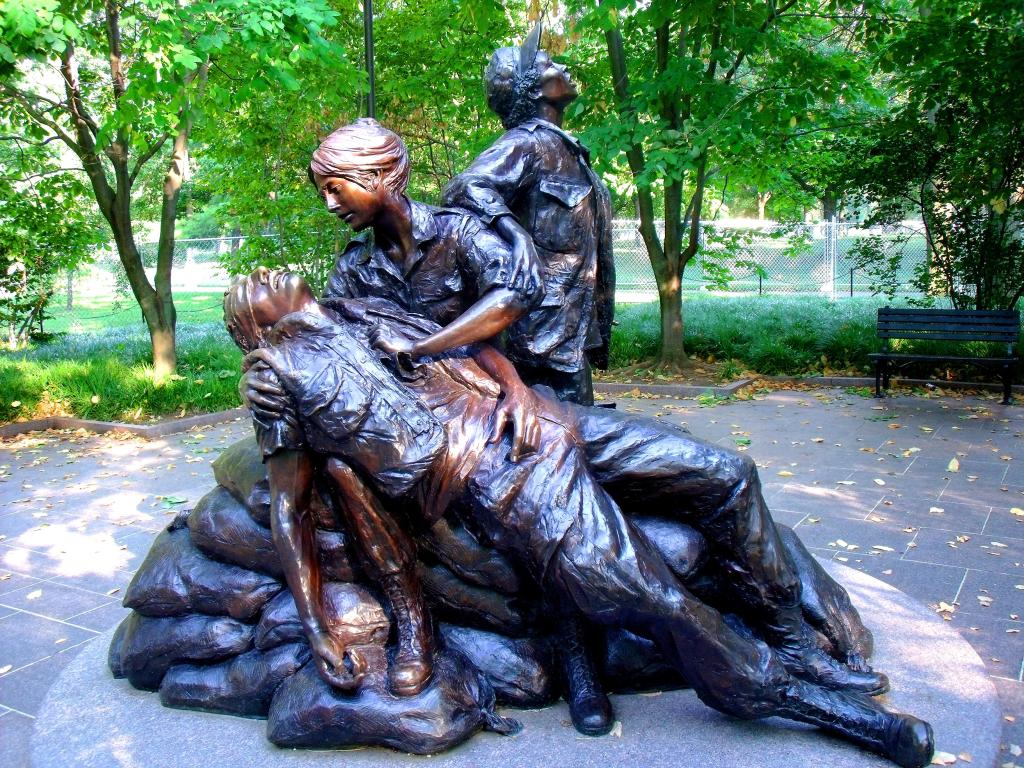
Lincoln Memorial
At the west end of the National Mall, at the end of the Reflecting Pool, you will find the Lincoln Memorial.
The Lincoln Memorial, honoring the 16th President of the United States, is another piece of neoclassical architecture in Washington DC and it is definitely one of the most iconic and visited landmarks of the city and of the United States. Inaugurated in 1922, it looks like an ancient Greek temple. Inside the temple, there is a huge statue of Lincoln seated on a chair. The Lincoln Memorial has a very special symbolic meaning related to civil rights movements. For instance, it was the place where Martin Luther King gave his famous “I have a dream” speech in 1963.
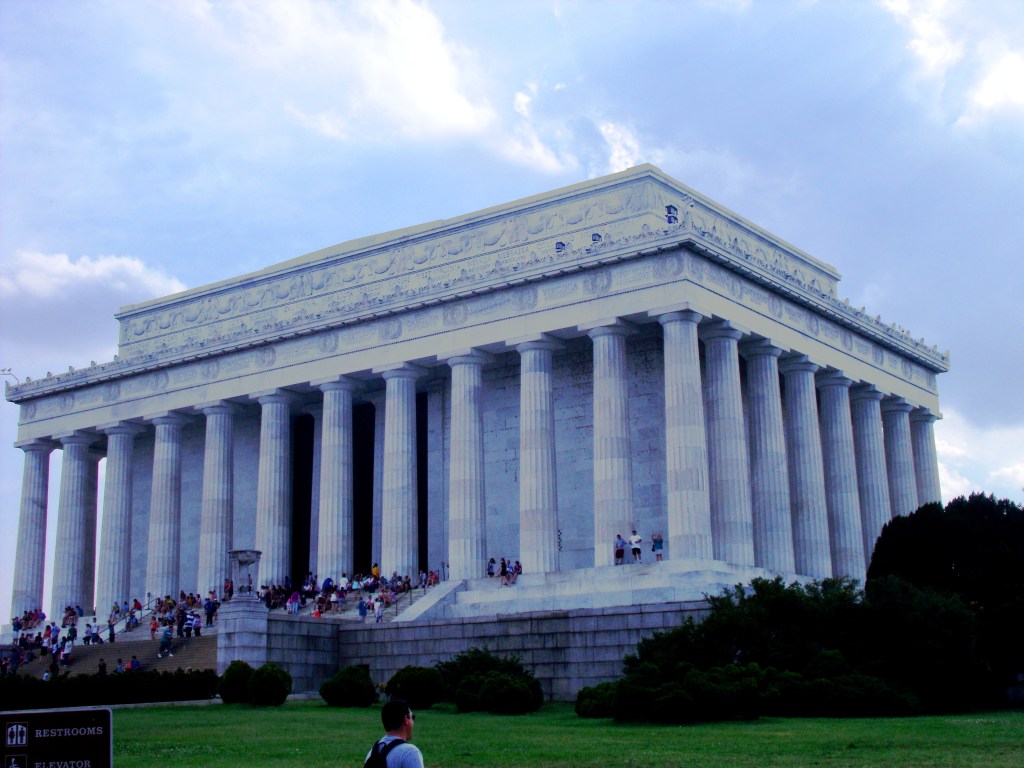
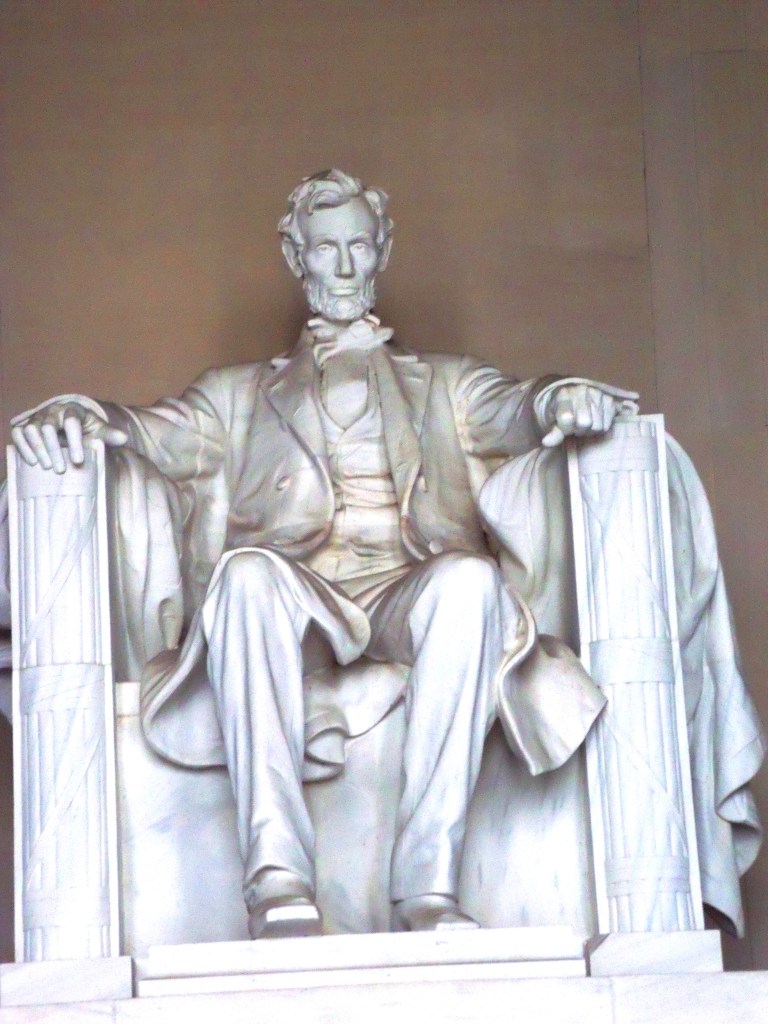
Korean War Memorial
Walking south from the Lincoln Memorial, you will find the Korean War Memorial, dedicated to those who perished during the Korean War. This is another quite touching place. It is made of several statues of marching soldiers.
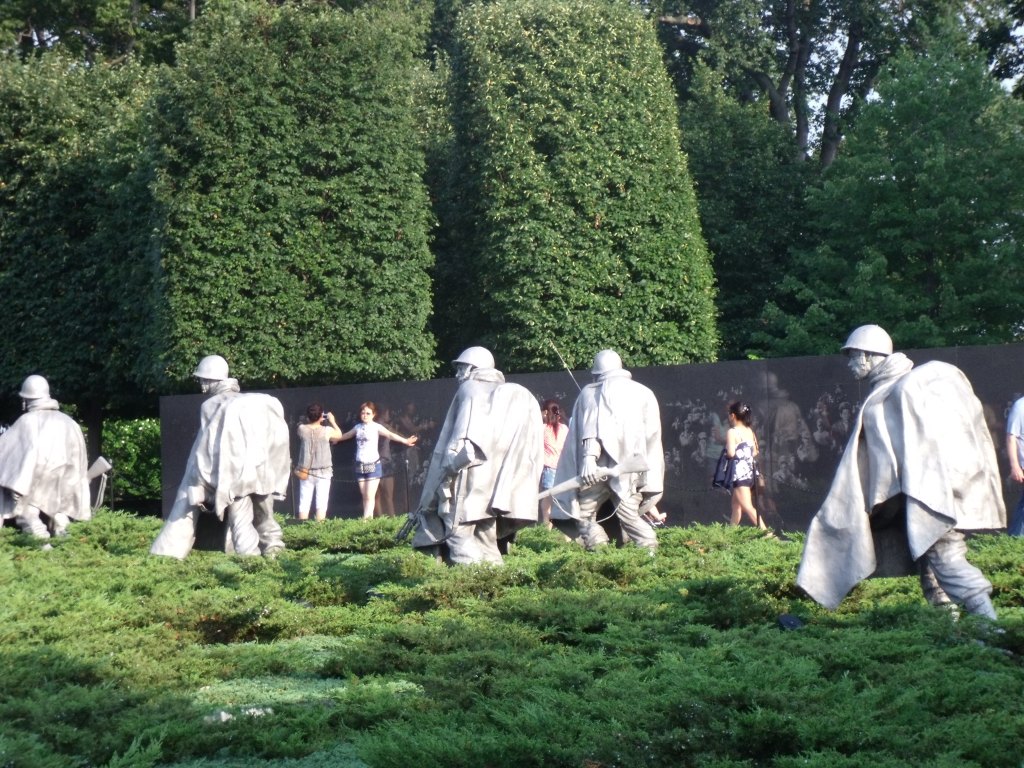
Franklin Delano Roosevelt Memorial
Walking south-east, you will get to the Tidal Basin, a 107-acres reservoir. On its west side you will find the Franklin Delano Roosevelt Memorial.
The Franklin Delano Roosevelt Memorial (also known as FDR Memorial) is a huge granite complex made of five outdoor rooms and several waterfalls on their walls. It was built in 1997 in honor of the 32nd United States President, who served from 1933 to 1945. On the walls of the Franklin Delano Roosevelt Memorial you can read many of his thoughts, which are still so true nowadays. The following quote of FDR was the most relevant to me.
“Men and nature must work hand in hand. The throwing out of balance of the resources of nature throws out of balance also the lives of men.”
Franklin Delano Roosevelt, January 24, 1935
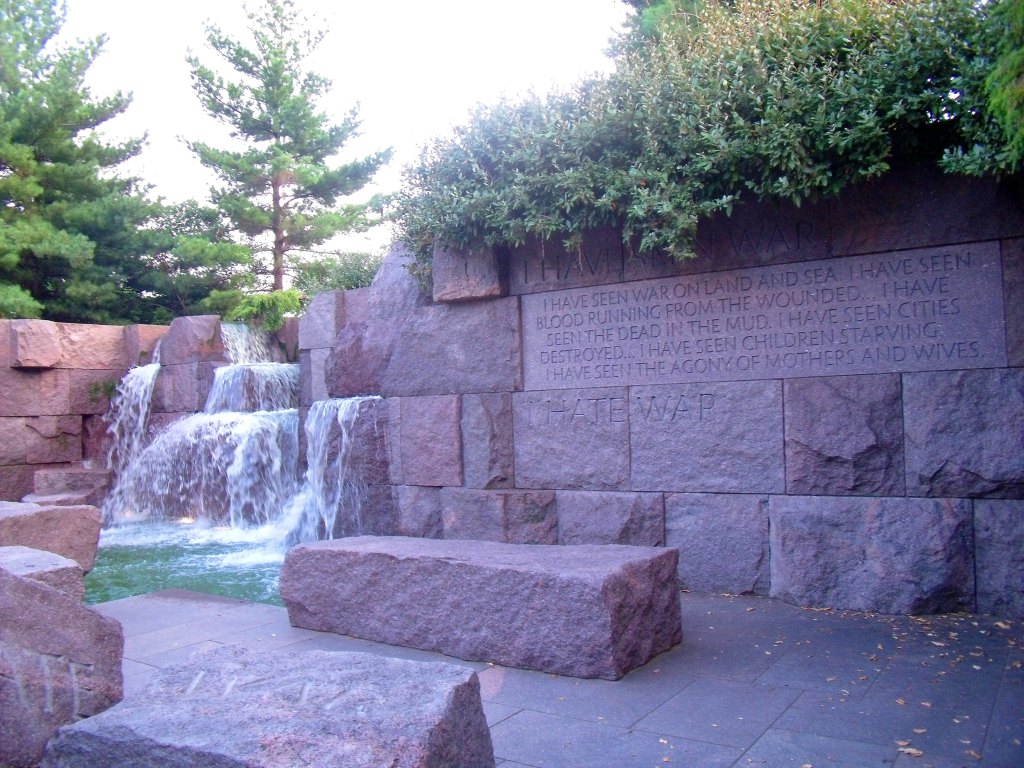
Thomas Jefferson Memorial
Walking along the Tidal Basin trail anticlockwise, after crossing a beautiful arched bridge, you will get to the Thomas Jefferson Memorial.
The Thomas Jefferson Memorial is dedicated to the author of the Declaration of Indipendence of the United States: Thomas Jefferson was one of the founding fathers of the nation and then became the 3rd President of the United States. The Thomas Jefferson Memorial is a circular structure featuring a colonnade in the typical neoclassical style. It was completed in 1943. Inside you will find a statue of Thomas Jefferson and excerpts of the Declaration of Indipendence are carved on the walls.

The Thomas Jefferson Memorial is also the perfect location to watch the sunset over the Tidal Basin.
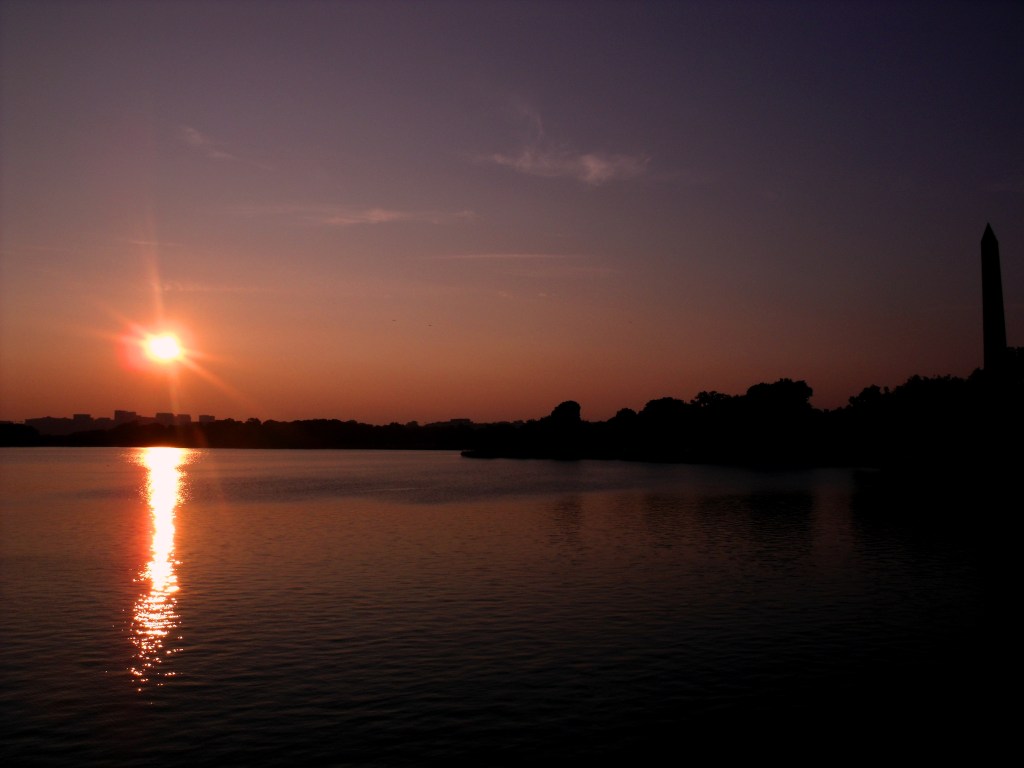
I remember at this point I was quite tired after the long day out and I asked a guy how far the Union Station was. He answered: “Damn man! It’s a long way!” So, I gathered my strength and walked the last miles back to my hotel, but rewarded by the beautiful landmarks I had been seeing during the day.
Did you like this post? What’s your favourite monument in Washington DC? Leave a comment below and follow me on social networks to get the latest updates!
If you need to book your accomodation, book now with Hostelworld or Expedia.
Washington DC: cosa vedere in un giorno in un itinerario a piedi
Disclosure: questo articolo contiene link di affiliazione: guadagnerò una piccola commissione se completerai un acquisto attraverso questi link, senza alcun costo aggiuntivo per te.
Washington DC: capitale degli Stati Uniti d’America, simbolo di potere, burocrazia e democrazia; centro di controversie politiche, scandali e tradimenti. Questo riassume cosa rappresenta Washington DC nell’immaginario collettivo.
Washington DC: cosa significa DC?
Washington DC non fa parte in realtà di nessuno stato degli USA: DC infatti sta per District of Columbia, il distretto autonomo di cui fa parte Washington.
Washington DC non è una città molto grande in confronto ad altre metropoli americane: la sua popolazione era pari a circa 705.000 persone nel 2019. La città si trova sul fiume Potomac sulla costa Est degli Stati Uniti e confina con Maryland e Virginia. Il nome della città onora il primo Presidente degli Stati Uniti, George Washington, mentre il nome del distretto ricorda Cristoforo Colombo.
Camminando lungo le strade di Washington DC, resterai meravigliato dalla sua architettura neoclassica: imponenti edifici e monumenti di marmo bianco caratterizzano la città, dandole un senso di austerità e potere con un forte legame verso il passato allo stesso tempo. Molti di questi luoghi di interesse sono famosi in tutto il mondo: la Casa Bianca, il Campidoglio, il Washington Monument ed il Lincoln Memorial solo per nominarne alcuni. Ti porteranno certamente alla mente molti luoghi dell’antica Grecia e dell’Impero Romano. Una passeggiata attraverso Washington DC è un viaggio attraverso la storia degli Stati Uniti, dalla loro indipendenza nel 1776 per poi passare alla guerra civile, ai due conflitti mondiali, alla guerra di Corea e alla guerra del Vietnam. Si tratta senza dubbio di un itinerario che non risparmia emozioni.
Quindi, in questo articolo parlerò di come visitare tutti i punti di interesse storici di Washington DC in un itinerario a piedi in giornata, con una piccola deviazione in Virginia! Lo so: è piuttosto serrato! Nel mio caso, ero arrivato a Washington DC il giorno prima, così da poter iniziare a visitare la città la mattina presto dopo una bella dormita. Suggerisco di fare altrettanto, altrimenti diventa tutto troppo frettoloso.
Come arrivare a Washington DC
Washington DC ha un aeroporto internazionale, chiamato Dulles International Airport (IATA: IAD), con collegamenti verso tutte le principali città in Europa. Ci sono altri due aeroporti nell’area metropolitana di Washington DC, il Ronald Reagan Washington National Airport (IATA: DCA) e il Baltimore/Washington International Thurgood Marshall Airport (IATA: BWI), con voli nazionali verso altre città degli USA.
Altrimenti, è possibile arrivare a Washington DC in treno o in autobus se si parte da altre città sulla costa Est. Verifica gli orari dei treni sul sito Amtrak, la compagnia ferroviaria nazionale degli USA. Ad esempio, io ho viaggiato in treno da Boston a Washington DC: il viaggio durò circa otto ore e fu molto rilassante. I treni partono dalla Union Station nel centro di Washington DC.
Infine, puoi prendere in considerazione di viaggiare in autobus con compagnie come Greyhound o Megabus: i biglietti sono molto economici se prenoti in anticipo. Dopo aver visitato la città, ad esempio, ho proseguito il viaggio in autobus da Washington DC a New York: il viaggio durò circa quattro ore e mezza.
Come muoversi a Washington DC
Il sistema di metropolitana Metrorail (chiamato semplicemente Metro) è il modo migliore per muoversi a Washington DC. La metropolitana è composta da sei diverse linee, ognuna identificata da un colore diverso. Per accedere alla metropolitana è necessario essere in possesso di una smart card. Verifica il sito Washington Metropolitan Area Transit Authority per maggiori informazioni su come muoversi a Washington DC.
Quando andare a Washington DC
Ho visitato Washington DC nel luglio 2011 e ricordo che fu una giornata molto calda con molta umidità. Di conseguenza, penso che il periodo migliore per andare a Washington DC sia in primavera o in autunno, quando le temperature sono più basse, in modo da rendere più gradevole la visita della città.
Itinerario a piedi in un giorno a Washington DC
Vediamo quindi come visitare i principali monumenti ed edifici storici di Washington DC in un itinerario a piedi in giornata. Non ho considerato i musei (lo Smithsonian in particolare), poichè richiederebbero più giorni. Ho considerato inoltre la Union Station come punto di partenza ideale per questo itinerario a piedi: naturalmente potrai riadattarlo per partire dal tuo alloggio a Washington DC. Ad esempio, io ho soggiornato allo splendido Renaissance Washington DC Downtown Hotel.
Come di solito, ho indicato sulla mappa solo i principali punti di interesse dell’itinerario. Inoltre, nell’angolo in basso a sinistra della mappa, puoi vedere il Cimitero Nazionale di Arlington (Arlington National Cemetery): per arrivarci è necessario prendere la metropolitana. Ecco quindi i punti di interesse di Washington DC indicati sulla mappa in un possibile ordine con cui visitarli in un itinerario a piedi in giornata. Molti di essi si trovano lungo il National Mall, il vasto parco che si estende da Capitol Hill sul lato est fino al Lincoln Memorial sul lato ovest.
- A: Washington Union Station
- B: United States Capitol
- Arlington National Cemetery (in metropolitana)
- C: Washington Monument
- D: White House
- E: Vietnam Women’s Memorial
- F: Lincoln Memorial
- G: Korean War Memorial
- H: Franklin Delano Roosevelt Memorial
- I: Thomas Jefferson Memorial
- J: Washington Union Station
Come puoi vedere, dopo aver visitato il Campidoglio degli Stati Uniti (the Capitol), puoi prendere la metropolitana e arrivare al Cimitero Nazionale di Arlington; dopo averlo visitato, potrai tornare nuovamente al National Mall in metroplitana. Se non hai tempo a sufficienza, puoi semplicemente saltare il Cimitero Nazionale di Arlington e proseguire l’itinerario attraverso il National Mall. Ti consiglio comunque di non perderti il Cimitero Nazionale di Arlington, essendo un’esperienza molto emozionante.
Senza considerare la visita al Cimitero Nazionale di Arlington, questo percorso ad anello è lungo circa 13,4 km complessivamente.
Iniziamo dunque questa passeggiata (o forse dovrei dire trekking?)!
Washington Union Station
Se arrivi a Washington DC in treno, avrai la prima impressione sull’aspetto della città alla Union Station, inaugurata nel 1907. Resterai meravigliato dalle sue maestose volte e dai suoi pavimenti di marmo bianco, che riflettono lo stile neoclassico così diffuso a Washington DC.

Di fronte alla Union Station, si trova la Freedom Bell, una copia della Liberty Bell di Philadelphia, simbolo dell’indipendenza americana.

Campidoglio (United States Capitol)
Camminando verso sud, si arriva al Campidoglio degli Stati Uniti, l’edificio dove il Congresso si riunisce. Si trova a Capitol Hill sul lato orientale del National Mall. Lo riconoscerai sicuramente, poichè lo avrai visto in TV moltissime volte. Costruito nel 1800, il Campidoglio è un bellissimo esempio di architettura neoclassica, caratterizzato da una maestosa cupola. È possibile visitare il Campidoglio gratuitamente: ricorda solo che è raccomandato prenotare in anticipo (i visitatori devono accedere dalla facciata orientale).

Dalla facciata occidentale del Campidoglio si ha una stupenda vista sull’intero National Mall. Proprio di fronte al Campidoglio, si trova inoltre lo Ulysses S. Grant Memorial, in memoria del generale della guerra civile.


Corte Suprema degli Stati Uniti (Supreme Court of the United States)
Situata ad un solo isolato a est del Campidoglio, il palazzo della Corte Suprema degli Stati Uniti è un altro esempio di architettura neoclassica e ricorda un antico tempio greco. Ispira autorità, giustizia e dignità. Anche l’edificio della Corte Suprema è aperto al pubblico gratuitamente.
Sull’architrave dell’entrata sul lato ovest di questo maestoso edificio sono incise le seguenti parole:
“Equal Justice Under Law”

Cimitero Nazionale di Arlington (Arlington National Cemetery)
Se desideri visitare il Cimitero Nazionale di Arlington (che consiglio vivamente), a questo punto puoi camminare verso sud lungo la First Street SE per un paio di isolati e prendere la metro alla Capitol South Station: prendi la linea blu verso Franconia-Springfield e scendi alla Arlington Cemetery Station.
Il Cimitero Nazionale di Arlington è considerato il suolo più sacro degli Stati Uniti: i suoi giardini coprono un’ampia area di 639 acri su una collina dove oltre 14.000 soldati americani riposano in pace. Visitare il Cimitero Nazionale di Arlington è sicuramente un’esperienza emozionante: ricorda di tenere un comportamento rispettoso quando visiti questo luogo.
All’estremità nord del cimitero, si trova lo US Marine Corps War Memorial, che ricorda le guerre combattute dai Marines americani nel corso degli anni.

Quindi puoi camminare lungo i vialetti sul lato della collina, fra le migliaia di tombe di pietra bianca che punteggiano il paesaggio. È impressionante quanto siano numerose.

Risalendo la collina, si trova la tomba del Presidente John F. Kennedy (President John F. Kennedy Gravesite), dove sono sepolti a suo fianco altri membri della famiglia; qui, una fiamma arde eternamente.
Infine, sulla cima della collina, si trova il Memorial Amphitheater: in questo imponente monumento neoclassico hanno luogo varie cerimonie commemorative durante l’anno. Inoltre, il Presidente di solito tiene qui un discorso durante il Memorial Day.
A fianco del Memorial Amphitheater, si trova la tomba del milite ignoto (The Tomb of the Unknown Soldier), sicuramente il monumento più iconico e famoso del Cimitero Nazionale di Arlington. La tomba del milite ignoto ricorda quei soldati deceduti che non sono stati identificati dopo la loro morte in guerra. Questa tomba di marmo bianco è il luogo di sepoltura di un soldato ignoto dalla Prima Guerra Mondiale. Oggi la tomba è sorvegliata 24 h su 24 e il cambio della guardia è una delle cerimonie più emozionanti a cui abbia mai assistito, essendo altamente simbolico. Durante il cambio della guardia al pubblico viene richiesto di rimanere in silenzio, il che rende questa cerimonia ancora più solenne. Su un lato della tomba è scritta la seguente frase:
“Here rests in honored glory an American soldier known but to God” (“Qui giace in gloria con onore un soldato americano noto solo a Dio”)

Washington Monument
Dopo aver visitato il Cimitero Nazionale di Arlington, puoi tornare al National Mall in metropolitana: è sufficiente riprendere la linea blu in direzione opposta, stavolta verso Largo Town Center e scendere alla L’Enfant Plaza Station. Da qui cammina verso nord per un paio di isolati e sarai di nuovo al National Mall. Camminando verso ovest troverai il Washington Monument, un altro iconico luogo di interesse della città, alto circa 169 m. Questo enorme obelisco di marmo fu completato nel 1888 in onore di George Washington. È possibile salire sulla cima del Washington Monument grazie all’ascensore al suo interno: è necessario però acquistare il biglietto il giorno precedente.

La Casa Bianca (The White House)
Dal Washington Monument, puoi quindi proseguire verso nord lungo la 15th Street NW, fino ad arrivare a Pennsylvania Avenue. A questo punto gira a sinistra in questa strada pedonale chiusa al traffico. Dopo pochi passi, alla tua sinistra, al numero 1600 di Pennsylvania Avenue NW, troverai uno fra gli edifici più famosi al mondo, la Casa Bianca (the White House), la residenza del Presidente degli Stati Uniti. Completata nel 1800, la Casa Bianca è un ulteriore esempio di architettura neoclassica. A differenza di altri edifici a Washington DC, una visita alla Casa Bianca deve essere pianificata con largo anticipo: i visitatori americani devono contattare il loro membro del Congresso, mentre i visitatori internazionali devono rivolgersi alla loro ambasciata a Washington DC.

Memoriale della Seconda Guerra Mondiale (World War II Memorial)
Dopo aver scattato alcune foto alla Casa Bianca, puoi continuare a camminare lungo Pennsylvania Avenue e quindi girare a sinistra in 17th Street NW: dopo alcuni isolati sarai di nuovo al National Mall e, alla tua destra, troverai il Memoriale della Seconda Guerra Mondiale (World War II Memorial).
Il World War II Memorial, completato nel 2004, onora i soldati americani che hanno partecipato e sono caduti durante la Seconda Guerra Mondiale. Questo imponente monumento circolare è composto da 56 pilastri, ognuno rappresentante uno degli stati o territori americani, due archi alle estremità nord e sud ed una fontana al centro.

Vietnam Veterans Memorial e Vietnam Women’s Memorial
Camminando verso ovest attraverso il World War II Memorial, si incontra la Lincoln Memorial Reflecting Pool, uno specchio d’acqua artificiale rettangolare. Alla sua estremità, alla tua destra, troverai prima il Vietnam Women’s Memorial e quindi il Vietnam Veterans Memorial, una parete nera in granito dove sono incisi i nomi dei soldati americani caduti durante la guerra del Vietnam. Come nel caso del Cimitero Nazionale di Arlington, questi monumenti suscitano forti emozioni.


Lincoln Memorial
Alla estremità occidentale del National Mall, alla fine della Reflecting Pool, è situato il Lincoln Memorial.
Il Lincoln Memorial, in onore del XVI Presidente degli Stati Uniti, Abraham Lincoln, è un altro esempio di architettura neoclassica a Washington DC e senza dubbio è uno dei monumenti più iconici e visitati della città e degli Stati Uniti. Inaugurato nel 1922, ricorda un tempio dell’antica Grecia. All’interno del tempio, si trova una enorme statua di Lincoln seduto su una sedia. Il Lincoln Memorial ha un significato simbolico molto speciale legato ai movimenti per i diritti civili. Ad esempio, è stato il luogo dove Martin Luther King tenne il famoso discorso “I have a dream” nel 1963.


Korean War Memorial
Camminando verso sud dal Lincoln Memorial, si trova il Korean War Memorial, dedicato ai soldati deceduti durante la guerra di Corea. Si tratta di un altro luogo che non lascia indifferenti: è composto da una serie di statue di soldati in cammino.

Franklin Delano Roosevelt Memorial
Camminando verso sud-est, si arriva al Tidal Basin, un lago artificiale di 107 acri. Sul suo lato occidentale si trova il Franklin Delano Roosevelt Memorial.
Il Franklin Delano Roosevelt Memorial (conosciuto anche come FDR Memorial) è un enorme complesso in granito composto da cinque stanze all’aperto e varie cascate lungo le pareti. Fu costruito nel 1997 in onore del XXXII Presidente degli Stati Uniti, che ricoprì il ruolo dal 1933 al 1945. Sulle pareti del Franklin Delano Roosevelt Memorial è possibile leggere molti dei suoi pensieri, che sono ancora molto attuali ai giorni nostri. La seguente citazione è quella che mi ha colpito di più:
“Men and nature must work hand in hand. The throwing out of balance of the resources of nature throws out of balance also the lives of men.” (“Uomini e natura devono lavorare mano nella mano. Rovesciando l’equilibrio delle risorse naturali, si rovescia anche l’equilibrio delle vite degli uomini.”)
Franklin Delano Roosevelt, 24 gennaio 1935

Thomas Jefferson Memorial
Percorrendo in senso antiorario il Tidal Basin trail, dopo aver attraversato un bel ponte caratterizzato da arcate, si arriva al Thomas Jefferson Memorial.
Il Thomas Jefferson Memorial è dedicato all’autore della Dichiarazione di Indipendenza degli Stati Uniti: Thomas Jefferson fu infatti uno fra i padri fondatori della nazione e divenne poi il terzo Presidente degli Stati Uniti. Il Thomas Jefferson Memorial è caratterizzato da una struttura circolare con un colonnato nel tipico stile neoclassico. Fu completato nel 1943. All’interno si trova una statua dello stesso Thomas Jefferson e alcuni estratti della Dichiarazione di Indipendenza sono incisi sulle pareti.

Il Thomas Jefferson Memorial è anche il luogo perfetto per godersi il tramonto sul Tidal Basin.

Ricordo a questo punto di essere stato piuttosto stanco dopo la lunga giornata fuori e chiesi ad un tipo quanto lontano fosse la Union Station. Mi rispose: “Damn man! It’s a long way!” (“Accidenti amico, è lunga la strada!”). Così, raccolsi le forze e percorsi gli ultimi chilometri verso l’hotel, ma ben ricompensato per la splendida giornata trascorsa.
Ti è piaciuto questo articolo? Qual è il tuo monumento preferito di Washington DC? Lascia un commento qui sotto e seguimi sui social networks per restare sempre aggiornato!
Se hai bisogno di prenotare il tuo alloggio, prenota ora attraverso Hostelworld o Expedia!

I visited once a long time ago but would like to return. Thanks for sharing.
LikeLike
Hi, you are welcome! I visited the city almost ten years ago now, but I still have good memories of those days.
LikeLiked by 1 person
Wow that was a long post! I really hope I get to visit DC one day, I’ve always wanted to.
LikeLike
Thanks Nina! Yes, you should definitely visit Washington DC: I really liked it!
LikeLike
Great walking tour! Love the map with the route and all of the pictures are great!
LikeLike
Thanks Jenn! I am glad you liked it! I really appreciate it!
LikeLike
I’ve visited D.C. several times and the architecture is my favorite!
LikeLike
Thanks!!! Yes, the architecture is definetely amazing!
LikeLike
Visited Washington DC in the Winter. Can’t wait to visit in the warmer months
LikeLike
Thanks for your feedback, Kevin! You should definitely visit in spring or summer too!
LikeLike
Very detailed itinerary. I can remember visiting most of these as a kid with my dad. Hope to get back and take my kids to DC.
LikeLike
Thanks for your feedback Greg! I really appreciate it! I am glad the post brought back good memories!
LikeLike